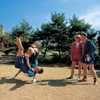europe | Sambo
페이지 정보
작성자 WoMAU 작성일11-07-27 1,119회 댓글0건관련링크
본문
Sambo
Russia

1. History
The founders of Sambo deliberately sifted through all of the world's martial arts available to them to augment their military's hand-to-hand combat system. One of these men, Vasili Oschepkov, taught judo and karate to elite Red Army forces at the Central Red Army House. He was one of the first foreigners to learn Judo in Japan and had earned his nidan (second degree black belt, out of then five) from judo's founder, Kano Jigoro. Oschepkov used some of Kano's philosophy to formulate the early development of the new Soviet art.
Sambo was in part born of native Russian and other regional styles of grappling and combative wrestling, bolstered with the most useful and adaptable concepts and techniques from the rest of the world.
Over the centuries, the inhabitants of what is now known as Russia had had ample opportunity to evaluate the martial skills of various invaders: from the Vikings in the West and from the Tatars and Genghis Khan's Golden Horde from Mongolia in the East. The regional, native combat systems included in Sambo's genesis are Russian fist fighting, Tuvan Khuresh, Yakuts khapsagai, Chuvash akatuy, Georgian chidaoba, Romanian trinta, Armenian kokh, and Uzbek Kurash to name a few.
The foreign influences included various styles of European wrestling, catch wrestling, Japanese jujutsu, French savate, muay thai and other martial arts of the day plus the classical Olympic sports of amateur boxing, Greco-Roman wrestling and freestyle wrestling. Sambo even derived lunging and parrying techniques from the Italian school of swordsmanship.
2. Philosophy
Sambo (Russian: самбо; САМозащита Без Оружия), also called Sombo, is an acronym for SAMozashchita Bez Oruzhiya which means "defense without weapons", in Russian, is a martial art and combat sport.
3. Contents
1) Technic
2) Style
There are three generally recognized competitive sport variations of Sambo (though Sambo techniques and principles can be applied to many other combat sports).
Sport Sambo (Russian: Борьбa Самбо,Bor'ba Sambo) is stylistically similar to amateur wrestling or judo. The competition is similar to judo, but with some differences in rules, protocol, and uniform. For example, in contrast with judo, Sambo allows some types of leg locks, while not allowing chokeholds and focuses on throwing, ground work and submissions.
Combat Sambo (Russian: Боевое Самбо, Boyevoye Sambo). Utilized and developed for the military, Combat Sambo resembles modern mixed martial arts, including extensive forms of striking and grappling where (unlike Sport Sambo) choking is legal. Competitors wear jackets as in sport sambo, but also hand protection and sometimes shin and head protection. The first FIAS World Sambo Championships were held in 2001.
Freestyle Sambo - uniquely American set of competitive Sambo rules created by the American Sambo Association (ASA) in 2004. These rules differ from traditional Sport Sambo in that they allow choke holds and other submissions from Combat Sambo that are not permitted in Sport Sambo as well as certain neck cranks and twisting leg locks. Freestyle Sambo, like all Sambo, focuses on throwing skills and fast ground work. No strikes are permitted in Freestyle Sambo. The ASA created this rule set in order to encourage non-Sambo practitioners from judo and jujitsu to participate in Sambo events.
3) Rank & Grade
A Sambo practitioner normally wears either a red or a blue jacket kurtka, a belt and shorts of the same color, and sambovki (Sambo shoes). The Sambo uniform does not reflect rank or competitive rating. Sport rules require an athlete to have both red and blue sets to visually distinguish competitors on the mat.
In Russia, a competitive rating system is used rather than belt colors like judo and jiujitsu to demonstrate rank, though some schools around the world now institute belt colors as well. The rating system is called Unified Sports Classification System of the USSR, with the highest athletic distinction known as the Distinguished Masters of Sport in Sambo.
Examination requirements vary depending on the age group and can vary from country to country. The examination itself includes competitive accomplishment as well as technical demonstration of knowledge. Higher level exams must be supervised by independent judges from a national Sambo association. For a rating to be recognised, it must be registered with the national Sambo organization.
4. Organization
□ web-site
http://www.sambo.com
댓글목록
등록된 댓글이 없습니다.



